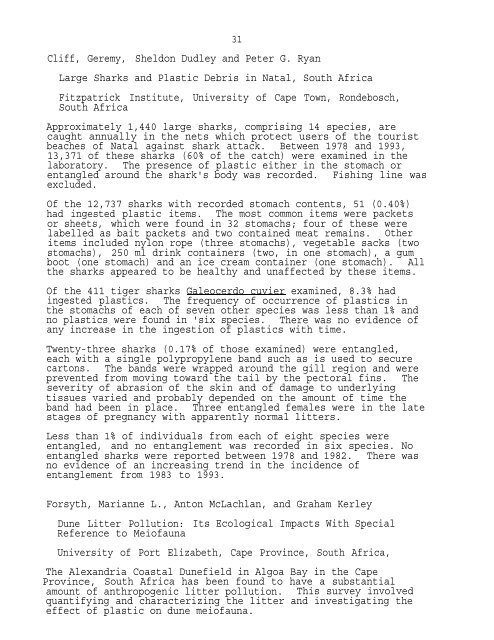Poster abstracts and manuscripts from the Third International ...
Poster abstracts and manuscripts from the Third International ...
Poster abstracts and manuscripts from the Third International ...
You also want an ePaper? Increase the reach of your titles
YUMPU automatically turns print PDFs into web optimized ePapers that Google loves.
Cliff, Geremy, Sheldon Dudley <strong>and</strong> Peter G. Ryan<br />
Large Sharks <strong>and</strong> Plastic Debris in Natal, South Africa<br />
Fitzpatrick Institute, University of Cape Town, Rondebosch,<br />
South Africa<br />
31<br />
Approximately 1,440 large sharks, comprising 14 species, are<br />
caught annually in <strong>the</strong> nets which protect users of <strong>the</strong> tourist<br />
beaches of Natal against shark attack. Between 1978 <strong>and</strong> 1993,<br />
13,371 of <strong>the</strong>se sharks (60% of <strong>the</strong> catch) were examined in <strong>the</strong><br />
laboratory. The presence of plastic ei<strong>the</strong>r in <strong>the</strong> stomach or<br />
entangled around <strong>the</strong> shark's body was recorded. Fishing line was<br />
excluded.<br />
Of <strong>the</strong> 12,737 sharks with recorded stomach contents, 51 (0.40%)<br />
had ingested plastic items. The most common items were packets<br />
or sheets, which were found in 32 stomachs; four of <strong>the</strong>se were<br />
labelled as bait packets <strong>and</strong> two contained meat remains. O<strong>the</strong>r<br />
items included nylon rope (three stomachs), vegetable sacks (two<br />
stomachs), 250 ml drink containers (two, in one stomach), a gum<br />
boot (one stomach) <strong>and</strong> an ice cream container (one stomach). All<br />
<strong>the</strong> sharks appeared to be healthy <strong>and</strong> unaffected by <strong>the</strong>se items.<br />
Of <strong>the</strong> 411 tiger sharks Galeocerdo cuvier examined, 8.3% had<br />
ingested plastics. The frequency of occurrence of plastics in<br />
<strong>the</strong> stomachs of each of seven o<strong>the</strong>r species was less than 1% <strong>and</strong><br />
no plastics were found in 'six species. There was no evidence of<br />
any increase in <strong>the</strong> ingestion of plastics with time.<br />
Twenty-three sharks (0.17% of those examined) were entangled,<br />
each with a single polypropylene b<strong>and</strong> such as is used to secure<br />
cartons. The b<strong>and</strong>s were wrapped around <strong>the</strong> gill region <strong>and</strong> were<br />
prevented <strong>from</strong> moving toward <strong>the</strong> tail by <strong>the</strong> pectoral fins. The<br />
severity of abrasion of <strong>the</strong> skin <strong>and</strong> of damage to underlying<br />
tissues varied <strong>and</strong> probably depended on <strong>the</strong> amount of time <strong>the</strong><br />
b<strong>and</strong> had been in place. Three entangled females were in <strong>the</strong> late<br />
stages of pregnancy with apparently normal litters.<br />
Less than 1% of individuals <strong>from</strong> each of eight species were<br />
entangled, <strong>and</strong> no entanglement was recorded in six species. No<br />
entangled sharks were reported between 1978 <strong>and</strong> 1982. There was<br />
no evidence of an increasing trend in <strong>the</strong> incidence of<br />
entanglement <strong>from</strong> 1983 to 1993.<br />
Forsyth, Marianne L., Anton McLachlan, <strong>and</strong> Graham Kerley<br />
Dune Litter Pollution: Its Ecological Impacts With Special<br />
Reference to Meiofauna<br />
University of Port Elizabeth, Cape Province, South Africa,<br />
The Alex<strong>and</strong>ria Coastal Dunefield in Algoa Bay in <strong>the</strong> Cape<br />
Province, South Africa has been found to have a substantial<br />
amount of anthropogenic litter pollution. This survey involved<br />
quantifying <strong>and</strong> characterizing <strong>the</strong> litter <strong>and</strong> investigating <strong>the</strong><br />
effect of plastic on dune meiofauna.
















